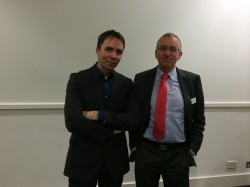 Wizz CEO Jozsef Varadi with John Strickland When airline ‘Wizz” kid Jozsef Varadi woke his wife to tell her he’d been sounded out to take the hot seat as CEO for the struggling Hungarian national carrier Malev , she told him “You’d be really stupid to take it”.
With good reason: He’d left the world of highly profitable multinational Procter and Gamble where he’d worked since graduation – to become Malev’s CCO . Accepting the position of CEO in a highly political company like Malev must have seemed like an almighty risk.
And as Varadi disclosed to me in a keynote interview for the 2014 World Travel Market, he was not in the best frame of mind to consider it. He was out socialising when the Chairman called him to a midnight meeting “somewhere” in Budapest. “I told him I’m half drunk.” But the chairman insisted and the meeting went ahead.
Despite his wife’s initial doubts Varadi accepted the job at 8.am the next day. The rest is history. He went on to engineer a big turnaround for Malev before leaving for yet another challenge. That was the creation of Wizz and there’s no doubt that, at that time, Varadi and his colleagues saw opportunities in the east of Europe where others didn’t.
The key moment was in 2004 when 10 countries joined the EU, providing the essential catalyst to the birth of Wizz. This created a vast newly accessible market. It couldn’t have happened earlier given the fallout from 9/11 and if he’d left it till later, competitors would have exploited the opportunity. The airline took its first steps in the Polish market beginning services from Katowice Airport which he says was in the middle of nowhere and felt like a “a hut”. Then it had only around 200,000 passengers per year. Today the figure is more than two million, largely thanks to Wizz’s development.
The airline has expanded carefully. From the outset Varadi’s team saw it as a pan country model and today it serves 35 countries. But the company sticks to its strengths, linking the eastern European markets which it knows best, to Western Europe – and now as far east as Dubai. Economic growth rates in much of Eastern Europe are double those in the west.
Varadi looked to Boeing and Airbus as potential suppliers of aircraft but drew different responses. At Boeing he was met with a lack of interest. Or in his more colourful language: “They sent us to hell”! However Airbus did take the risk with the fledgling airline and today Wizz has more than 50 A320’s in its fleet with big orders outstanding including some larger A321’s which will have 230 seats.
Varadi and his team have the same zealous focus on costs that Ryanair is respected for. It has succeeded in a perilous climate where others have failed. Malev, Varadi’s old employer went bankrupt in 2012. A rival eastern European LCC, Sky Europe, lost its way and also went out of business.
The customer base which was routed in ethnic worker traffic is now much more diverse – with many small businesses and leisure travellers. Even the beleaguered UK supermarket Tesco puts its executives on Wizz. According to Varadi many other companies are waking up to the fact that flying business class on short haul flights amounts to paying for “the most expensive coffee in your life”.
Varadi has shown skill in riding the turbulence of rough economic and political times; not least the conflict in Ukraine, yet the business remains profitable. A planned IPO earlier this year was pulled when financial markets took a dive. A wise decision. It’s all about timing. Given the track record of the management team and its ability to make crucial judgements, I’d expect Wizz’s moment for a successful float to come at a carefully chosen time in the not too distant future. For above all, Varadi has clearly demonstrated his instinct for seizing the right moment.
See my full interview at the World Travel Market here.
The atmosphere at the Farnborough Air Show is always electric – with the excitement of new aircraft types and the buzz of new orders. Plane manufacturers set out their stalls and airlines cluster round like bees at the aviation industry’s honey pot. But this year is there a danger of a shopping frenzy?
Ahead of the Show I caught up with Boeing’s VP Marketing, Randy Tinseth, who was in London to reveal the company’s Commercial Market Outlook. I wondered what he might see in his crystal ball? In fact, what Boeing does see is a need for almost 37,000 new aircraft over the next 20 years. Whilst 42% are seen as replacement aircraft, 58%, ( 21,000 aircraft) are for growth.
Much is explained by the increased frequency in direct flights enabled by smaller long haul wide bodies such as Boeing’s 787 and Airbus’s A350 – and much too by the continued rise of short haul Low Cost Carriers and growing Asian markets.
Of course a forecast is a forecast and Boeing does “caution” very effectively. Only time will tell how well current projections match reality but at present there is certainly evidence that there may be storm clouds on the horizon for at least some of the industry’s airlines.
I recently debated with one European CEO as to how and if the market can absorb the slew of short haul capacity coming its way with massive orders from amongst others, Ryanair, easyJet, Norwegian and IAG.
We’ve already had profit warnings from Air France KLM and Lufthansa, both worrying about excess capacity across the North Atlantic.
Lufthansa has revealed a new strategy to tackle its woes including capacity cuts and plans to launch a mini Long Haul Low Cost from late next year.
This move to long haul LCC is in itself a broader development that seems to becoming fashionable: Norwegian has started its US flights from Gatwick, Canada’s Westjet is trying some modest forays into Europe and talking about adding wide body capacity. Airbus’s decision to launch the new A330 NEO with its lower capital and seat costs could encourage others to join in too.
Add this to the melting pot of the Gulf carrier’s who are in my view more coherent in their expansion plans and it seems to me that in some cases – though not all – the need for capacity discipline is in danger of being overlooked.
Regarding Boeings’ market outlook, the long-term trend is always upwards – but can the industry succeed in retaining and improving on its historic but fragile profitability?
It’s issues like these that make Farnborough such a fascinating place to be in the summer.
 Just back from Dubai, where I was impressed by how the arid desert landscape is nurturing some stunning success stories for low cost airlines in the region. Just back from Dubai, where I was impressed by how the arid desert landscape is nurturing some stunning success stories for low cost airlines in the region.
Take Air Arabia, now 10 years old. It’s Chief Executive Officer, Adel Ali, has been there from start. His inspiration for the airline came from understanding the potential monotony of crossing the desert for anyone in a rush.
There were then 600 weekly buses leaving the UAE (United Arab Emirates) for destinations around the Gulf and Adel recognized the boredom that the bus passengers can face. After the first kilometer the next 1,000 kilometers would be exactly the same. Endless sand punctuated with checkpoints. Nor was it cheap to take one of these buses. This simple understanding of the passenger market has repaid him in spades.
It was easier to get people off the buses with affordable flights, but harder to tempt passengers off rival carriers due to early misconceptions of low cost carriers. Never the less the airline filled 60% of seats within 2 months and broke even in its first year. It’s been a story of profit ever since – with the model extended to Morocco and Egypt and just this May, Ras Al Khaima in the UAE.
This is pretty impressive when you consider the airline has had to roll with the punches of the Arab spring, the tensions in Egypt and now in Ukraine. One solution has been to move aircraft around, exploiting new opportunities thus keeping the company profitable.
It’s worth remembering that not everyone in the Gulf is rich and there is a demand for low fares. Yet Adel has succeeded in creating a company that can attract passengers and manage finances. He successfully launched the airline on the stock market becoming the only quoted gulf carrier.
The CEO of the Saudi low cost carrier FlyNas has had different challenges to face. Raja Azmi arrived with vast experience in the successful Asian low cost air market, Air Asia, as well as long haul Air Asia X. However the Saudi market is different.
The national airline, Saudia has been protected and it was felt that there was not a level playing field – with the state airline benefiting from subsidised fuel. This, along with domestic fare capping, are 2 issues that need “sorting out”.
Under Raja ,FlyNas has evolved into a hybrid low cost carrier “plus”. It has high service standards and even a business class. Untypically for an LCC it has recently gone into long haul – a model that is not yet proven in the global market. However, FlyNas sees the opportunity to tap into the unique Saudi religious market. 5 million passengers travel by air to make the Umrah pilgrimage to Mecca and Raja expects to get a fair share of that on routes from the UK and Malaysia for example.
The key message coming out of this region was full of optimism, vision and energy. Not arid at all.
Earlier this year I met CEO of Heathrow Airport, Colin Matthews. I subsequently interviewed him at this year’s World Travel Market.
He has plenty on his agenda. The government established the independent Airports Commission chaired by Sir Howard Davies to look at the tricky question of what should be done about the capacity bottle neck at London’s principal airports. Heathrow, the UK’s only hub airport is, in effect, full.
After a frantic period of lobbying from different airports, putting forward their plans for new hub capacity, the Airport Commission has delivered their interim report. No final recommendations will be made until after the next election, well into 2015.
A very long wait for such an important issue yet one shrouded in toxic political debate.
Hub airports are key strategic assets; there are only a handful around the world. They offer multiple itinerary choices to customers by facilitating connections between multiple short and long haul flights.
Colin Matthews is optimistic that the Commission will reach, what he describes as “good conclusions.” Of course it’s the politicians who have to implement them.
The UK has many great airports and several are making their claims to be the future hub. It’s certainly a significant challenge for the Commission to square off the competing claims.
The reality is, with only two home grown hub carriers British Airways and Virgin Atlantic, the UK can only sustain one hub. Heathrow has made its case for expansion and Matthews highlights some of the issues. Could we have a multi hub system? Some cite New York as an example but only Newark functions as a hub, JFK is a point to point airport. The airport system there has less long haul flights than Frankfurt, less short haul than Atlanta.. Could an Alliance group move to another airport? Even Star gets quite a lot of feed from BA at Heathrow and alliances are very fluid entities with tough regulatory limitations preventing schedule and pricing cooperation.
The debate is often framed as if Government can dictate where airlines fly (this has happened in the past), but ultimately it’s the airlines who will decide where to fly. Faced with high fuel prices & in many cases, difficult market conditions airlines have to put their aircraft where the money is. Aircraft are truly mobile assets, they don’t have to come to the UK. If the capacity isn’t available at the right UK hub airport they will go elsewhere in the world.
When I met British Airways CEO Keith Williams earlier this year at the airline’s Waterside Headquarters near Heathrow, he was in buoyant mood. British Airways is certainly the resilient half of IAG. It has been through the pain of restructuring and come out the other side. Whilst the UK economy is still in the doldrums, the London market, on which the airline relies, is strong. The financial services sector, a source of much long haul premium traffic for BA, has not returned to its former strength but this has more than been made up by strong performance in other market segments.
To Keith’s natural delight, all the revenue indicators are pointing in the right direction and that’s not the only good news. At Heathrow, BA is beginning to enjoy the fruits of its acquisition of bmi, allowing it decent room for growth even though the airport itself remains capacity strapped. It is discovering some useful new traffic flows, for example from some ex bmi Middle Eastern markets. Chengdu services are kicking off.
At Gatwick, where BA has struggled for a long time, staff reductions of 500 and outsourcing of ground handling are now allowing it to compete more effectively with LCC’s (Low Cost Carriers). Nevertheless with easyJet’s coming acquisition of Flybe’s Gatwick slots taking it close to 65% of the airport’s capacity against BA’s 15%, this challenge will intensify. There is also still the outstanding question of replacement of the elderly Gatwick based Boeing 737-400’s.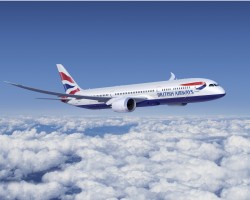
Long haul performance remains strong and this summer saw the delivery of BA’s first Boeing 787 Dreamliners & Airbus A380’s. Although the 787 deliveries were delayed due to the recent grounding of the type, BA had originally expected them in 2010 so is almost used to re planning schedules. With hopefully no more glitches such as the Ethiopian fire, the Dreamliners are getting to work as planned on Toronto and Newark services this autumn. With Austin just announced, they can start to deliver the promise of future growth potential.
Meanwhile the A380’s also start to earn their keep, increasing seat capacity on LA and Hong Kong services and freeing up slots for use on other routes.
If all this goes to plan and revenues stay firm, then mellow autumn, traditionally strong for business traffic, should be ripe for harvesting for Keith and his team at British Airways.
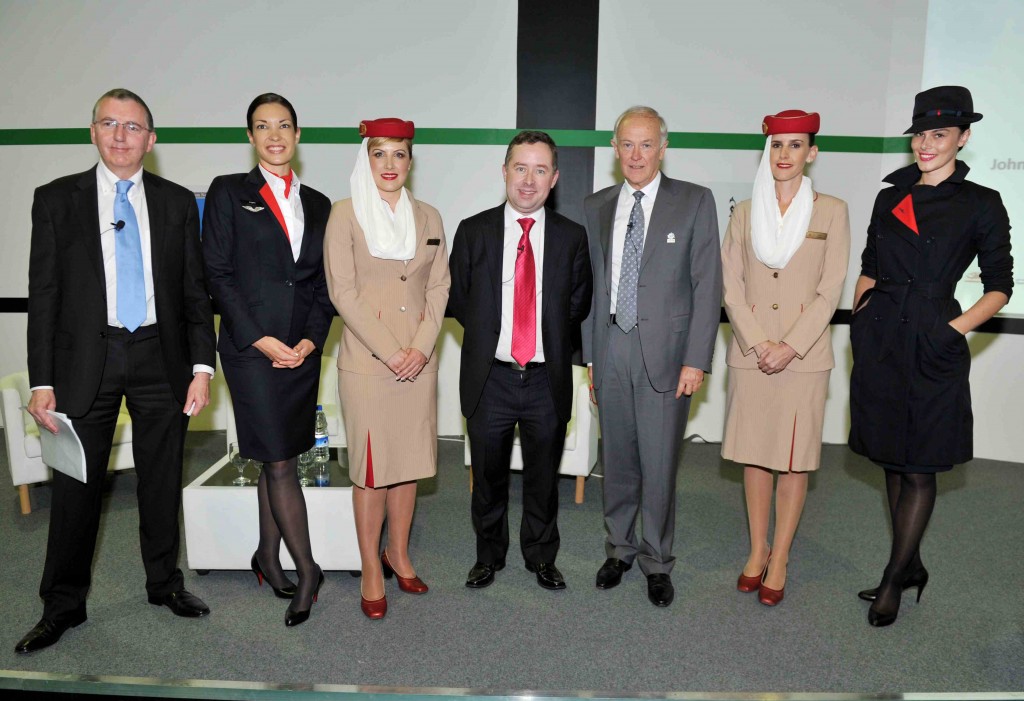 Tim Clark, President Emirates Airline, Alan Joyce CEO Qantas and John Strickland I recently had the opportunity to interview President of Emirates Airline, Tim Clark and CEO of Qantas, Alan Joyce in Dubai at WTM’s sister event, the Arabian Travel Market. Their new far reaching partnership embracing extensive collaboration on schedules, pricing and product, particularly between markets in Australia and Europe, is an example of how the air transport market continues to change dramatically.
Working together the two airlines have an opportunity to significantly improve their joint profitability whilst also benefiting travellers who will travel on some of the most modern aircraft in service and transit the state of the art facilities at Emirates’ Dubai hub
It is ironic for an industry which operates on such a global basis, that frequently airlines find themselves shackled with regulation based on narrow national interests. Qantas and Emirates, two airlines from different parts of the world, have managed to circumnavigate these complications to conclude their deal but there needs to be more consolidation on these lines
We’ve seen several big US companies come together (United And Continental, Delta And Northwest) and we expect the regulatory green light for the merger of American Airlines and US Airways. In Europe we have seen consolidation via the Lufthansa Group of airlines, Air France KLM and IAG (British Airways and Iberia). IAG has also taken majority ownership of successful low cost carrier, Vueling
These steps should help to secure better long term stability and financial success for the industry but they don’t yet really indicate a pan continental realignment on a global scale.
The Emirates Qantas deal is more of this ilk and I would expect to see others of this kind in the future. Certainly the leading members of the airline community recognise that global rather than only national or regional linkages are the way to go.
As Willie Walsh, CEO of IAG, said at the recent meeting of industry group IATA, people shouldn’t judge the future shape and health of the industry by anything that has happened in the past. We could be witnessing the start of a new world order.
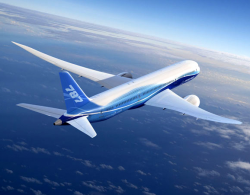 As the first quarter of 2013 approaches its conclusion, activity in the airline world is already off to a “flying” start-or not-as the case may be… As the first quarter of 2013 approaches its conclusion, activity in the airline world is already off to a “flying” start-or not-as the case may be…
One of the biggest pieces of news has been the grounding of Boeing’s long awaited 787 Dreamliner.
Problems with the aircraft’s batteries are proving tricky to diagnose and rectify. Boeing has received approval from the U.S. Federal Aviation Administration for its plan to test and certify improvements to the 787’s battery system but it is still likely to be an agonising few months for Boeing and its customers. Not only are aircraft grounded but new ones are not being delivered. The problem will compound as more airlines become due to accept aircraft and introduce them to service.
Headaches no doubt for airline network planners.
Airlines including the UK’s Thomson Airways and British Airways are having to re plan summer flight schedules which were due to be operated by the Dreamliner. We’ve learned of Qatar Airways delaying the introduction of new routes and cutting capacity on others. LOT Polish airlines has taken the 787 out of its planned summer schedule. Norwegian is due to introduce long haul low cost services for the first time without the requisite aircraft to do so. It will have to rent in alternative capacity. How easy will this be to find and at what price?
Let’s put it in context. All new aircraft face inevitable teething troubles. In my career I’ve seen problems with several aircraft including the venerable Boeing 747 “Jumbo”. There were early snags with Airbus’s short haul work horse, the A320-nick named by engineers in the early days, “the ground bus” & the McDonnell Douglas DC-10. These early difficulties were all (sometimes painfully) overcome and the aircraft went on to become commercially successful, giving sterling service over many years. Only last year the focus was on Airbus’s giant A380 wing cracks, a problem now understood and being resolved.
Some in the industry believe that, for the 787 things are likely to get worse before they get better, but let’s be clear, they will get better. Perhaps what this does show is the pressure on manufacturers’ to meet airline requirements for better fuel efficiency, improved payload and range characteristics. This dictates a need to innovate, to “push the envelope” and turn to new materials, technology and manufacturing processes.
The industry cannot escape this current painful process. It has to take brave leaps forward. But in order to do so, it also has to accept that there will be problems to overcome on the way – including coping with the ensuing publicity. It is therefore better to take the short term pain now in the interests of the long term gain that this will ultimately bring-for airlines, for passengers, for manufacturers.

One of the most challenging issues for the UK aviation sector currently is a lack of clear Government policy on the importance of the industry to support Britain’s economic recovery and growth. Wrapped up in this is the question of how best to use existing airport capacity and the contentious topic of additional runways in the south east of England.
The industry does itself no favours in publicly espousing a variety of different views about the right solution. There is such a chorus of diverse voices. Different airports, different airlines, frequently saying different things. Music to the ears of politicians. A ready excuse for inaction. Individual agendas may have a greater or lesser amount of legitimacy but what is right for the UK overall?
Add to this the Governments recent announcement that it is to set up an independent commission to look at airport capacity and it’s an opportune moment to reflect on what is at stake.
A man with clear views on the topic is Lord Adonis, former Secretary of State for Transport, under the previous Labour Government. He will be discussing the issues at this year’s World Travel Market at London in November.
I caught up with him recently to get a flavour of what we can expect to hear.
There is much discussion about a proposed new estuary airport to the east of London, nick named “Boris Island”, after the Mayor of London who supports the idea. “It will be a big stretch to make it work” Adonis told me. “The issue goes back to the 70’s and the cancellation of Maplin, a big mistake in retrospect”.
Maplin Sands was an ill fated project to build an airport also in the Thames Estuary. “It had consent and was in the process of being constructed. We’ve had to make do make do and mend ever since”
Adonis sees a third runway at Heathrow as “the only immediately viable option” to provide urgently needed capacity to protect London’s gateway airport status and to fund airlines’ need to make connections between flights at the same airport.
“It’s not ideal, but we need the extra capacity now, given the constraints”
He believes the Government should appoint an independent review to look at all options and depoliticise the process.
Adonis says he is “not instinctively one to duck decisions”, he green lighted a third runway at Heathrow when Labour was in power, but acknowledges time was lost in the 2003-2009 period. Labour is now itself against a third runway but “calling for consensus on the way forward and would support an independent review”
He also highlights another thorny issue-the failure to have a “joined up” transport policy-coordinating and optimising road, rail and air links. He cites the example of Frankfurt which recently opened a new runway and has great high speed rail links.
If it can be done in Germany why can’t it be done in the UK!
Mixed mode (using both parallel runways at Heathrow for a mix of take offs and landings rather than dedicating each to one or the other) will “provide capacity and resilience”
The idea of using RAF Northolt, to the north of Heathrow as a type of overspill airport, perhaps for some short haul flights, is something Lord Adonis finds “Intriguing. It could be well worth looking at. Lots of issues for someone to get into”
After the sleepy weeks of summer, the autumn could prove a time for fractious discussions on these very important issues.
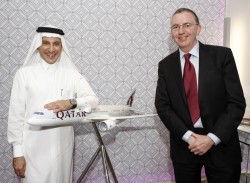 In 1997 Akbar Al Baker became CEO of Qatar Airways, then a little known local Gulf carrier. Today he heads a renowned global player powering ahead with new fleet and routes In 1997 Akbar Al Baker became CEO of Qatar Airways, then a little known local Gulf carrier. Today he heads a renowned global player powering ahead with new fleet and routes
At the recent Arabian Travel Market, I explored with him Qatar’s growth strategy and elicited his forthright views on the industry at large. To say it proved engaging would be an understatement!
I asked Al Baker if he was the Michael O’Leary of the Gulf “Of course, like Michael, I will be very aggressive in trying to achieve the aims that we have for the airline.”
He sees himself first and foremost as a businessman He believes in seizing every opportunity which is presented. In his early years the objective was 35 routes and aircraft. Today he plans to grow to 170 routes and a fleet to match in the next 3 years. “People know that when I start something I finish it” he says.
Only a fool would underestimate him. This is no ordinary airline CEO. His hands on style has driven the airline to where it is today and he is ready to grab more opportunities.
His philosophy on route development is to explore many new and underdeveloped markets where others might not see the opportunity. Sometimes even to the disbelief of his network planners.
This has lead to a big push into Africa with destinations such as Rwanda coming on line in recent months.
“Africa is underserved. Africans deserve more air services. Tourism today is not only being fed by Europeans like in the past but by (growing) affluence in Asia and China and we want to tap those markets” What else is in his vision? “Latin America: a huge economic machine…two major power houses in the east, China and India. A lot of synergies between these two developments”.
But does this make business sense? “Qatar Airways doesn’t fly aeroplane to carry fresh air to any destination …we are experts in moving capacity from market to market depending on the economic situation, the financial state of the world economy, the recession”.
Spoken as a true businessman, the singe mindedness and determination is apparent.
He believes in calculated risk taking based on macroeconomic indicators.
As far as aircraft manufacturers are concerned Qatar is not just a customer but gives a clear steer on what it needs and expects at the design stage. “Qatar is in the lead team (with Boeing). As a customer we sit in their aircraft development programmes, the same with Airbus”.
There have been some tense moments for Boeing and Airbus when they haven’t met expectation.
Al Baker insists that had Airbus taken on board Qatar’s views in the early design stages of the A350, that it would have flown ahead of the Boeing 787 rather than remaining at the design stage.
When I asked him about the prospects of China taking a key role on the aircraft manufacturing stage in the years to come, he cites massive recent change in the country’s capability to produce a wide range of quality products. He believes that China (and Russia), will compete effectively in the next 5-10 years. “Qatar Airways will be open to …buy these airplanes once they are properly certificated and tested”.
 On a real bête noir-the complaints by some European airlines’ about Gulf carriers (alleged subsidies, unfair advantages), Al Baker is combatitive. “The Europeans are the ones who taught us how to hub” He sees the plaintiffs using Gulf carriers as an easy excuse for their problems and in fact being afraid of competition and high service standards. “They have an unsustainable cost structure… and we are taking advantage”. He is not backward either in pointing out the value to European jobs of the massive Gulf carrier aircraft orders. On a real bête noir-the complaints by some European airlines’ about Gulf carriers (alleged subsidies, unfair advantages), Al Baker is combatitive. “The Europeans are the ones who taught us how to hub” He sees the plaintiffs using Gulf carriers as an easy excuse for their problems and in fact being afraid of competition and high service standards. “They have an unsustainable cost structure… and we are taking advantage”. He is not backward either in pointing out the value to European jobs of the massive Gulf carrier aircraft orders.
One European who Al Baker does hold in admiration is IAG’s Willie Walsh. “He turned around British Airways. I like people who (are prepared to) stand up and be counted…he recognises that there is competition; he knows that (it) will not go away… (He sees that) European carriers instead of screaming about Gulf carriers should try and cooperate”
This rapport doesn’t surprise me. Both CEO’s are single-minded and clearly focussed on a vision for their companies. Both are true individuals who are content not to hunt with the pack
He has clear views on the whole range of industry issues. He is very much master of his brief.
On consolidation: “We don’t believe in acquiring sick underperforming airlines. (Qatar wishes to)…get into a partnership with somebody that is already strong in what they are doing… (Not something), which will drain the management skills or the management time of Qatar Airways”
On low cost airlines: Al Baker is not convinced that the Gulf is truly conducive to the model. No huge population, no secondary airports and insufficient liberalisation. High ticket prices on routes with no competition. He believes Qatar can fight back with superior service and using revenue management to offer a limited number of lower fares.
Premium market: He argues cogently that there will always remain a market for premium service. That doesn’t mean cutting corners for the economy customer.
The way to cut costs is to make aircraft lighter, improve flight routings for fuel efficiency. He doesn’t believe in sacrificing the customer by trimming the dessert or putting less chicken in the casserole. Does Qatar make money from this approach? “We make money from that. Otherwise I will not be flying aeroplanes!”
On what gets him up in the morning: “I sleep very well, you know when you have a very good conscience you’ll always sleep well” Mind you, he tells me he wakes in the night with ideas and would like to start work on them straight away-not enough hours in the day!
Having met the man, I’d say any competitor who expects to find Al Baker napping had better think again!
See the interview
See Testimonials and Biography
 With IAG’s first annual results just out and showing promising financial progress it’s an opportune moment to reflect on whether the marriage between British Airways and Iberia is indeed a partnership made in heaven? With IAG’s first annual results just out and showing promising financial progress it’s an opportune moment to reflect on whether the marriage between British Airways and Iberia is indeed a partnership made in heaven?
Profits have been delivered-a better result than some peers are likely to report in the coming weeks. However rising fuel prices, the economy and pilot strikes are among the challenges already faced, so can this Anglo Spanish alliance take the strain?
I know from personal experience that any airline merger or integration is difficult from a human perspective, across different national cultures, even more so.
 Listening to IAG and Iberia Chairman Antonio Vasquez talking recently, he indicated that there are no egos to get in the way of progress and one senses a real rapport amongst the Spanish and British management team. This is something which should not be underestimated in assisting British Airways and Iberia make good early progress on a number of fronts. Listening to IAG and Iberia Chairman Antonio Vasquez talking recently, he indicated that there are no egos to get in the way of progress and one senses a real rapport amongst the Spanish and British management team. This is something which should not be underestimated in assisting British Airways and Iberia make good early progress on a number of fronts.
There are however, storm clouds to be faced too
On the upside, Antonio Vasquez is clear in his vision for the direction of the group, pointing out that BA and Iberia “had lived together” for some time before the official IAG union took place.
He explains that the uninspiring name IAG (actually International Consolidated Airline Group) was chosen explicitly so as not to detract from the well-known brands of Iberia and British Airways – and other future partners. While it is likely that other airlines will join the group – there is no immediate hurry to expand the family.
The media may have drawn up an ambitious wedding list of potential acquisitions when IAG was formed – but the reality is likely to be quite different.
What transpires from talking with CEO Willie Walsh is that any acquisition target must meet clear criteria to strengthen IAG’s position at their twin hubs in Heathrow and Madrid or reinforce the group’s position in key markets.
Portugal’s TAP is certainly of interest due to its extensive Brazil network but it will depend on when the Portuguese Government indicates it is willing to start a sale process
Bmi certainly makes sense and IAG will be hoping for regulatory approval of this during March. It represents a one shot chance for the BA side of the business to grow its position in a capacity constrained Heathrow
Could investment in Kingfisher now be on the cards? Too much to digest or an opportunity for the taking?
Meanwhile costs have been cut and synergies realised but as with all airlines IAG is battling with a rising fuel bill. Fortunately, revenues have held up over the last year, particularly long haul premium traffic. This could well slow in the year ahead. The Group cannot afford to let up in its cost focus. It’s a full time effort but one which has already caused staff frictions
Iberia is battling with its pilots about the setting up of a new lower cost subsidiary Iberia Express. As with BA’s cabin crew dispute, this shows both the difficulty in communicating serious business issues to an absent workforce. Iberia needs the short haul feed but it can’t sustain the short haul losses which are the consequence of tough competition with low cost carriers.
In my view, Willie Walsh had no choice but to tackle the cabin crew issues. It wasn’t about anti union dogma but about long term survival, which ultimately protects jobs. When asked about the current industrial relations challenge at Iberia, Vasquez is clear that Iberia Express has to have new thinking and new ways of doing things
On top of these internal issues IAG must keep its eye on the Chapter 11 Bankruptcy process of Joint Venture business partner American Airlines. Rumours abound of possible bids for the company. Vasquez is clear about the value of the partnership. If IAG has its way it will not only retain but deepen it.
There’ll be plenty to test the partnership in the months ahead. But in airline terms at least, it appears that there’s a lot to be said for “living together” to see if you have the basis of an enduring marriage.
See Testimonials and Biography
|
The most recent blog entries
|










Follow Us!